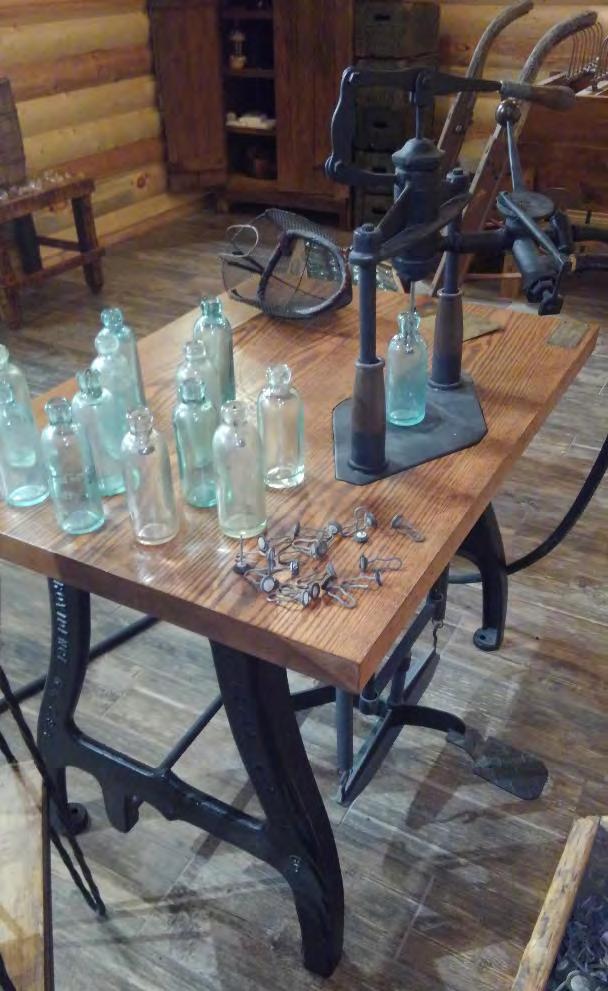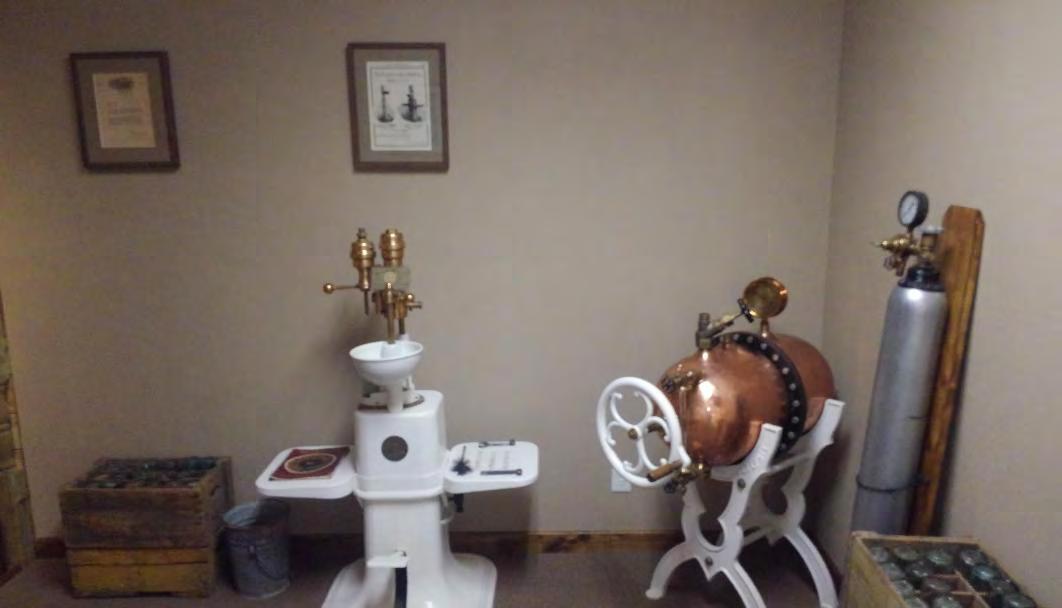
5 minute read
New Historical Bottling Museum is Now Open in Silsbee, Texas by Bill Baab
New Historical Bottling Museum is Now Open in Silsbee, Texas
By Bill Baab
Hutchinson filling and stopper station ready for production.
While growing up in this East Texas town, not a year passed when teenager Casey Roby did not hear of antique bottles called “Hutchinsons.” His “Uncle Woody,” a.k.a. Les Roby, was an enthusiastic collector of the bottles invented by Charles G. Hutchinson, son of a Chicago bottler, in 1879.
“I come from a rather large family,” Casey said, “and I recall as a boy the family gatherings at Grandma’s house for Christmas. Usually, you could find the men huddled in groups outside sipping on cups of coffee. To this day, I can hear my father asking Woody, ‘Hey, you ain’t found me any arrowheads lately, have you?’ My uncle would reply, ‘Naw, and you and Jackie haven’t seen any Hutch bottles, have you?’
“I swear this was the exact conversation I’d hear each year, but I never paid much attention to either subject. It wasn’t until many years later that I learned the true definition of a Hutchinson.”
Fast forward to 2005. Casey, 25, was a U.S. Army combat veteran. He left the service, found employment, purchased land and began construction on a new home.
“My wife, Alison, and I had discussed the home’s décor many times and mine was always some manly version of taxidermy or antiques. So during construction I decided that at least one room in the house was to be decorated the way I wanted. I decided on a rustic theme and began scouring antique malls for ideas.” (Suffice to say his Man Cave features a pool table and a set of antlers.)


An original syrup crock

From left, an original crown top bottle filling machine shares space with an S. Twitchell Carbonator, an original carbon dioxide carbonator manufactured by the Liquid Carbonic Co., Chicago.
And I wondered if they were like the Hutchinson bottles I’d heard about from Uncle Woody who had collected them all those years ago. That experience prompted some phone calls and subsequent research leading to my own interest in Hutchinson-era sodas. I collected, searched and dug for a few years before beginning to wonder about the industry itself. How and where the bottles were made? What kind of machinery was used?
That led to more research and a visit to the Coca-Cola Museum in Vicksburg, Mississippi. It was there I saw a bottling works display and I have been hooked ever since.
Enter Bob Harms, a Chicago collector of all things Hutchinson. One of the late Harms’ favorite expressions was ‘if it’s not a Hutchinson, it’s not a bottle!’ A tribute to Bob penned in 2007 by 1st Chicago Bottle Club’s John Panek and Ray Comorowski included the fact that “in the late 1970s or early 1980s, Bob purchased a Hutchinson bottling machine used by the Litchfield (Illinois) Bottling Works.” Bob was curious about how the machine worked, figured it out and was able to demonstrate it at various bottle shows.
“He came to the Houston Bottle Club show many years ago and set up the equipment to demonstrate how to fill Hutchinson bottles,” Casey said. “I’d heard the story from some of the senior collectors so many times that Bob’s demonstration must have left strong impressions. I started asking around and stumbled on a New Mexico collector named Zang Wood. Three years ago, he gave me some telephone numbers and e-mail addresses. I tried the phone numbers, but none worked so I gave up. Three years later, I looked
Another view of the filling station with bottles in crates ready to be taking to the wagon for delivery to the townspeople .

Hutchinson with original label in the meeting room at the museum.
through the paperwork again and noticed the e-mails. So I gave it a shot and one of those e-mails was still active. Turned out to be that of Carolyn, Bob’s daughter, and our conversation eventually led me to the purchase of the Hutch bottling equipment.”

crown top bottle filling machines manufactured by the Crown Cork & Seal Company. Ironically, the development of crown top bottles led to the extinction of Hutchinson bottles. “I’ve only been able to verify just a few of the crown top machines are still in existence in the U.S.,” Casey said.
Painting on the right depicts a rolltop desk in W.H. Hutchinson’s Chicago office.




Barrel appears to be filled with ice with two drinks getting cold. Museum owner Casey Roby said it was common to give youngsters visiting the bottling works a free soft drink to drink them on site. In this case, the “ice” is actually Epoxy. In the background is an original bottlers’ cabinet from the St. Augustine (Texas) Bottling Works.
A lifetime supply of Hutchinson stoppers from the Jacksonville, Texas Bottling Works. Here is carbon dioxide generator.
He has since added mineral water bottle look-alikes embossed W.H. Hutchinson & Son, Chicago, Illinois, but isn’t sure what they contained. All the bottling works room equipment is reproduction, with the Hutchinson filling table and carbon dioxide generator soon to be replaced by the real deals from Harms’ equipment. The bottlers’ supply cabinet is an original from the San Augustine (Texas) Bottling Works. The syrup crock also is an original.
“Once I am done with the restoration project on the equipment I purchased from Bob’s family, every item on the bottling works display will be all original,” he said. “I don’t know of another such facility in the United States.”
He has housed his historical bottling works inside a 1,500-square foot building constructed in 2015 and located at 7383 Cansler Road in Silsbee. Currently, the East Texas Historical Bottling Museum is open by appointment only on Friday, Saturday and Sunday evenings from 2 p.m. to 6 p.m. There is no admission charge, he said, but donations are gladly accepted. To reserve a visit, Casey can be reached on Facebook (Case Roby), or by calling (409) 658-4539.









